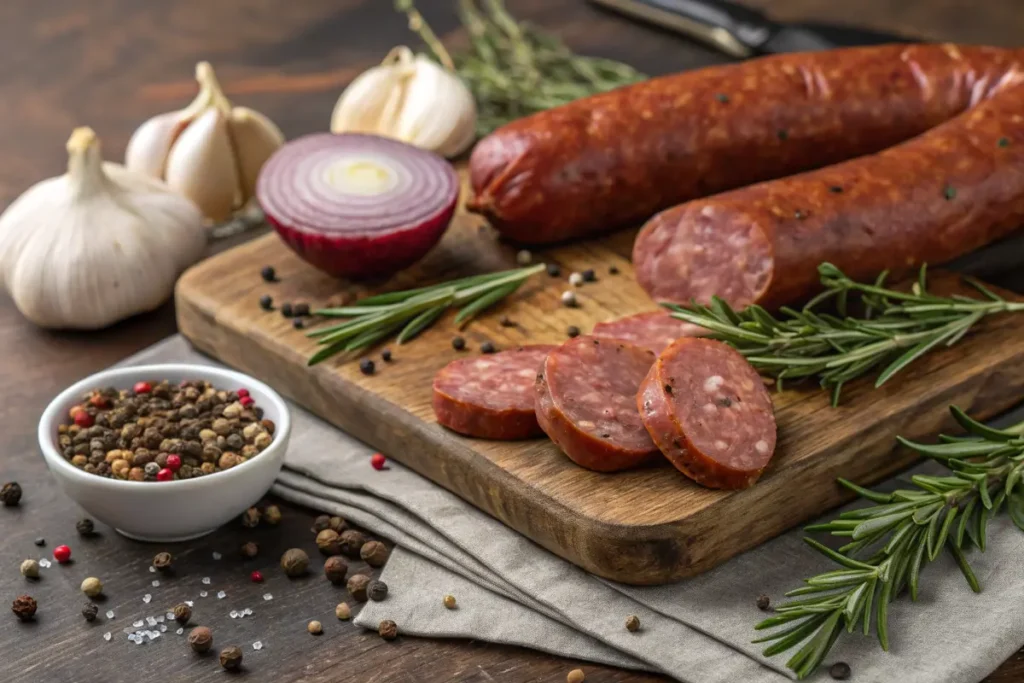Beef Sausage: Everything You Need to Know
Beef sausage is more than just a flavorful addition to your meals – it’s a versatile ingredient that can be enjoyed in many forms, from breakfast to dinner. Whether you’re a seasoned home chef or a beginner, this article will guide you through everything you need to know about beef sausage. From understanding its different types and flavors to discovering how to cook it perfectly, we’ve got you covered. So, let’s dive into the juicy details about this deliciously versatile ingredient!
Introduction to Beef Sausage
What Is Beef Sausage?
At its core, beef sausage is a savory, flavorful blend of beef and seasonings that are stuffed into a casing to create a delicious sausage link. It’s a staple in many cuisines around the world, prized for its rich taste and satisfying texture. Depending on how it’s prepared, it can be either raw, which requires cooking, or smoked, ready to eat straight out of the package. While most sausages are made from pork or chicken, beef sausage stands out for its unique, hearty flavor, often enhanced with spices like garlic, paprika, or fennel. It’s enjoyed in a wide range of dishes, from sizzling grilled sausages to hearty stews and casseroles.
Brief History and Evolution of Beef Sausage
The history of beef sausage is deeply intertwined with the evolution of sausage making itself. Sausage-making dates back to ancient times, with evidence pointing to the Sumerians in Mesopotamia. Originally, sausages were created as a way to preserve meat before refrigeration was available, and they often included a mixture of meats and herbs to add flavor. Over the years, beef sausage has evolved, particularly in regions where beef is a primary source of protein, such as in the United States and parts of Europe. Today, we see a wide variety of beef sausages, from gourmet creations made with premium cuts to more economical options made with ground beef and spices. This evolution has given rise to many styles, including smoked beef sausage, fresh beef sausage, and even exotic variations like spicy jalapeño cheddar beef sausages.
Types of Beef Sausages Available

Fresh vs. Smoked Beef Sausages
When it comes to beef sausage, one of the first decisions you’ll face is whether to go for a fresh or smoked variety. Fresh beef sausages are typically raw and need to be cooked before eating. They are often juicier and tender, allowing the flavors of the beef and spices to meld together while they cook. These sausages are great for grilling or pan-frying, giving them that crispy, caramelized exterior while keeping the inside soft and juicy.
On the other hand, smoked beef sausages are already cooked, giving them a rich, smoky flavor. They’re perfect for those looking for a quick meal or snack, as you can eat them straight from the package or reheat them. Smoked sausages also have a firmer texture and a more intense flavor due to the smoking process, which infuses the meat with a distinctive taste that pairs beautifully with everything from sandwiches to salads.
Different Varieties of Beef Sausage: Kielbasa, Bratwurst, and More
Within the world of beef sausage, you’ll find a variety of distinct types, each with its own characteristics and flavor profiles. Kielbasa, a Polish-style sausage, is one of the most popular beef sausages. It’s usually smoked and flavored with garlic, marjoram, and other spices, giving it a robust and savory taste. Kielbasa is often served with sauerkraut or in soups, making it a comforting dish during colder months.
Then, there’s bratwurst, a German sausage that’s typically made from a mix of beef and pork, though you can also find 100% beef versions. It’s seasoned with spices like caraway, nutmeg, and white pepper. Bratwurst is commonly grilled or pan-fried and served in a bun with mustard or sauerkraut.
Other beef sausage varieties include spicy chorizo, which is popular in Spanish and Mexican dishes, and Italian beef sausage, often used in pasta dishes or on pizzas. No matter your taste, there’s a beef sausage variety out there to suit your cravings, whether you’re in the mood for something bold, spicy, or savory.
Beef Sausage Ingredients and Flavors

Common Ingredients Used in Beef Sausage
The beauty of beef sausage lies in its simplicity and versatility. At its core, beef sausage is typically made from ground beef, fat, and a mix of seasonings. However, the real magic happens with the addition of spices and herbs that elevate the flavor. Below is a table showing some of the most common ingredients found in beef sausages, along with their typical amounts:
| Ingredient | Purpose | Typical Amount |
|---|---|---|
| Ground Beef | The main protein base, providing texture and flavor | 1 lb (454 g) per batch |
| Beef Fat | Adds moisture and richness to the sausage | 2–3 oz (57–85 g) |
| Garlic | Adds savory depth and aroma | 1–2 cloves (5–10 g) |
| Onion Powder | Enhances flavor with a slight sweetness | 1 tsp (2 g) |
| Black Pepper | Adds a mild heat and enhances overall seasoning | 1/2 tsp (1 g) |
| Paprika | Adds mild smokiness and sweetness | 1 tsp (2 g) |
| Fennel | Often used in Italian-style sausages for a licorice flavor | 1/2 tsp (1 g) |
| Thyme | Aromatic herb that adds earthiness | 1 tsp (1 g) |
Sometimes, additional ingredients like onions, cheese, or even fruits like apples are added to provide a unique twist. For example, a spicy jalapeño cheddar beef sausage will include the heat from fresh jalapeños along with the creamy, sharp flavor of cheddar cheese. Whether it’s a hint of sweetness from caramelized onions or a touch of heat from chili flakes, the ingredients play a big part in defining the sausage’s overall flavor.
Popular Seasonings and Their Impact on Flavor
The seasonings used in beef sausage aren’t just there for flavor—they’re a crucial part of the sausage-making process, enhancing the texture and helping to preserve the meat. For instance, garlic and onion powder are staples in many beef sausages, providing a savory base that complements the beef. Paprika adds a subtle smoky sweetness, while black pepper gives the sausage a slight bite.
Some sausages, like Italian beef sausage, use herbs such as oregano and basil, bringing an aromatic depth to the meat. Meanwhile, sausages like chorizo often incorporate a blend of spicy seasonings like cayenne pepper, cumin, and oregano, giving them their signature fiery kick. These seasonings not only add flavor but also enhance the overall eating experience, creating sausages that can be enjoyed on their own or as part of a dish.
Health Aspects of Beef Sausage
Nutritional Breakdown of Beef Sausage
When it comes to enjoying beef sausage, one of the most important considerations is its nutritional value. Beef sausage can be a hearty and flavorful addition to any meal, but it’s essential to understand what goes into it.
Typically, beef sausage is rich in protein, making it a great choice for anyone looking to boost their daily protein intake. A single 3-ounce (85g) serving can provide about 15–20 grams of protein, depending on the brand and ingredients. However, it’s also important to note that beef sausage can be high in fat and sodium, which is a common trait in most sausages. One serving can contain anywhere between 20–25 grams of fat, with about 8–10 grams of that being saturated fat.
Additionally, beef sausage is often seasoned with salt, which contributes to its sodium content. Depending on the type of sausage, one link may contain up to 600–800 milligrams of sodium. While this is fine as an occasional treat, if you’re watching your salt intake, it’s important to be mindful of your portion sizes.
Is Beef Sausage Healthy? Pros and Cons
Like any food, beef sausage has its pros and cons. On the positive side, it’s a fantastic source of iron, zinc, and vitamin B12, all of which play vital roles in maintaining energy levels, immune function, and overall health. Beef sausage also offers a satisfying, savory flavor that can be hard to replicate with other meats.
However, the downsides can’t be ignored. Due to its high fat and sodium content, beef sausage isn’t necessarily the healthiest choice if consumed in large quantities or on a daily basis. The key is moderation. If you’re aiming for a healthier version, consider opting for leaner cuts of beef or sausage options with fewer additives and preservatives. Always check the label to ensure you’re making the healthiest choice!
How to Cook Beef Sausage
Best Cooking Methods for Beef Sausage
Cooking beef sausage is simple, but the method you choose will significantly affect its flavor and texture. The most common ways to cook beef sausages are grilling, pan-frying, baking, or boiling.
- Grilling: This is perhaps the most popular way to cook beef sausage, as it imparts a smoky flavor and crispy texture. Simply preheat your grill, place the sausages over medium heat, and cook for 8–10 minutes, turning occasionally, until browned and cooked through.
- Pan-frying: Another great option, pan-frying results in a delicious, crispy exterior. Heat a little oil in a skillet, and cook the sausages over medium heat for about 8–10 minutes, turning them to ensure they cook evenly.
- Baking: If you prefer a hands-off approach, baking is the way to go. Preheat your oven to 375°F (190°C), place the sausages on a baking sheet, and bake for 20–25 minutes, turning halfway through.
Tips for Perfectly Cooking Beef Sausage Every Time
While cooking beef sausage may seem straightforward, there are a few tips that can help ensure the perfect outcome every time.
- Don’t Overcook: Overcooking beef sausage can lead to a dry, rubbery texture. Aim for a golden-brown exterior with a juicy, tender interior. The ideal internal temperature for cooked beef sausage is 160°F (71°C).
- Prick with a Fork: Some people recommend pricking the sausages with a fork to avoid bursting, but it’s generally not necessary unless you’re grilling. Pricking allows juices to escape, so you may lose some flavor.
- Rest After Cooking: Let your cooked sausages rest for a few minutes before serving. This helps retain the juices inside, ensuring a more flavorful bite.
These methods will help you get the most out of your beef sausage, giving it that perfect balance of crispy and juicy. Whether grilling, pan-frying, or baking, beef sausage can easily become the star of your meal! For another delicious recipe that combines bold flavors and energy-boosting ingredients, check out this Brazilian Mounjaro recipe for energy.
Beef Sausage vs. Other Types of Sausages
Comparing Beef Sausage and Chicken Sausage
When you’re deciding what type of sausage to cook with, you’ll likely find yourself choosing between beef sausage, pork sausage, and chicken sausage. Each type has its unique flavor profile and characteristics, which make them suitable for different types of dishes.
Beef sausage stands out for its rich, hearty flavor. It’s often juicier and more robust compared to pork or chicken sausage. The natural richness of beef gives it a bolder taste, which makes it perfect for hearty dishes like stews, casseroles, and even grilled sausages.
Chicken sausage is the leanest of the three, making it a great option for those looking for a lighter, lower-fat alternative. While it’s not as juicy as beef or pork sausage, chicken sausage can still pack a punch with its variety of flavorings, from spicy to sweet, often incorporating ingredients like apples, spinach, or herbs.
Flavor Differences Between Beef and Other Sausages
The flavor differences between beef sausage and other types of sausages can be quite striking. Beef offers a deep, savory taste that’s less greasy than pork sausage and more intense than chicken sausage. However, the richness of beef sausage can sometimes overpower lighter dishes, so it’s best paired with ingredients that can stand up to its bold flavor.
Popular Brands of Beef Sausage
Top Beef Sausage Brands You Can Try
When it comes to choosing beef sausage, the brand can make a significant difference in terms of flavor, texture, and overall quality. There are plenty of top-notch brands offering premium beef sausage, and here are a few to keep an eye out for:
- Kiolbassa: Known for its high-quality, smoked beef sausages, Kiolbassa offers a variety of flavors, from classic smoked to spicy jalapeño. Their sausages are made with no nitrates or fillers, giving them a cleaner taste.
- Teton Waters Ranch: Specializing in grass-fed beef sausages, Teton offers sausages with a cleaner taste and a leaner profile. Their products are perfect for those who prefer organic, sustainably sourced meat.
- Hillshire Farm: A household name in the sausage industry, Hillshire Farm offers a wide range of beef sausages that are widely available and affordable. Their smoked beef sausages are a great option for casual meals.
- Aidells: While Aidells is best known for its chicken sausage, they also offer gourmet beef sausages in unique flavors like pineapple and bacon. Aidells provides a great balance between flavor and quality.
What Makes a Great Beef Sausage Brand?
When selecting a beef sausage, the most important factors to consider are the quality of the meat, the seasoning, and the preparation methods. A great beef sausage brand will use high-quality, fresh beef and avoid unnecessary fillers or additives. Look for brands that offer clear, simple ingredients and focus on enhancing the natural flavor of the beef with a well-balanced blend of spices.
Beef Sausage Recipes to Try
Classic Beef Sausage Dishes: From Grilled to Sausage Stew
When it comes to beef sausage, there are plenty of classic recipes that allow its rich, savory flavor to shine. One of the most popular and easy options is simply grilling beef sausage. You can cook them on a barbecue or a stovetop grill pan for a smoky, crispy exterior. Pair them with sautéed onions, peppers, and a side of mustard, and you have a meal that’s full of flavor with minimal effort.
Another fantastic way to enjoy beef sausage is in a hearty stew. Beef sausage works beautifully in slow-cooked dishes, where the flavors meld together over time. Try adding sliced sausage to a vegetable or bean stew. The richness of the sausage infuses the broth, adding layers of savory goodness that make the dish truly comforting.
Creative Ways to Use Beef Sausage in Your Meals
Beyond the classics, there are plenty of creative ways to use beef sausage in your cooking. For instance, try slicing it up and adding it to pasta dishes like spaghetti or penne, where the sausage can add a satisfying bite. You can also make a delicious breakfast hash by pan-frying chopped beef sausage with potatoes, bell peppers, and onions.
For a quick and easy meal, beef sausage is also perfect for making savory sandwiches. Grill or pan-fry the sausages, then serve them on a toasted bun with your favorite toppings like cheese, lettuce, and pickles. The possibilities are endless, whether you’re cooking for a crowd or just preparing a quick weeknight dinner.
FAQs About Beef Sausage
What Are the Best Beef Sausage Recipes for Beginners?
If you’re new to cooking with beef sausage, the best place to start is with simple dishes. Grilled sausages are easy to prepare and don’t require much effort. Simply season your sausages, grill them until golden brown, and pair with sautéed vegetables or a side of potatoes. You can also try making a classic sausage and peppers dish, which is full of flavor but simple enough for beginners.
Can Beef Sausage Be Frozen?
Yes, beef sausage can absolutely be frozen! If you have extra sausages or want to stock up, simply place them in an airtight container or freezer bag and store them in the freezer. They can be kept for up to three months. When you’re ready to cook, just thaw the sausages in the fridge overnight or cook them straight from frozen, though cooking times may be slightly longer.
Is Beef Sausage Gluten-Free?
Most beef sausage options are naturally gluten-free, as they are typically made from ground beef, spices, and fat without any added wheat or gluten-containing ingredients. However, it’s always important to check the label, especially if you’re buying pre-packaged sausages. Some brands may add fillers or binders that contain gluten, so make sure to look for sausages that are labeled “gluten-free” if you have a gluten sensitivity.


